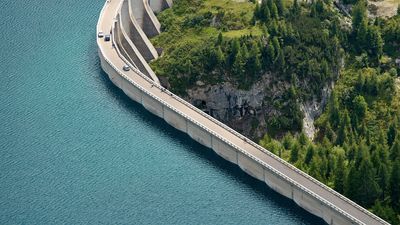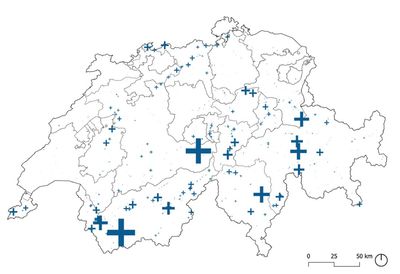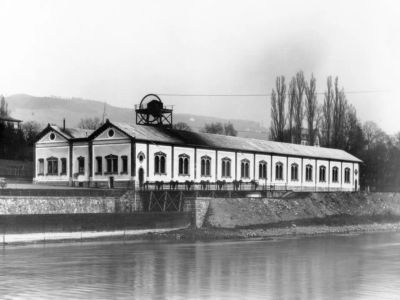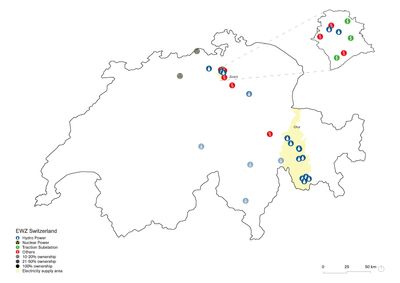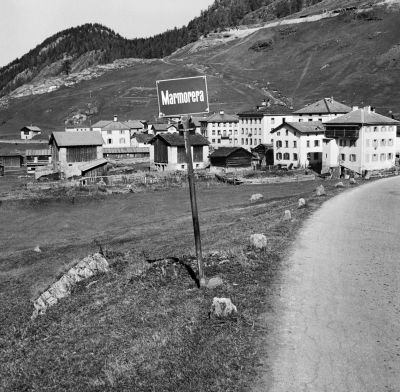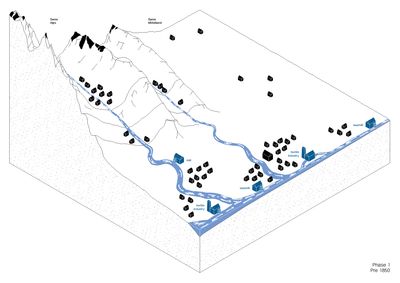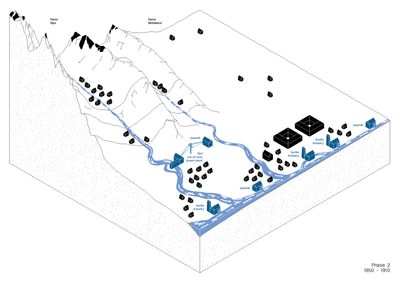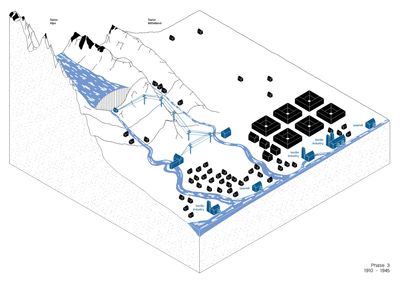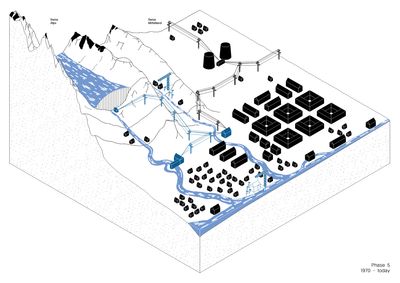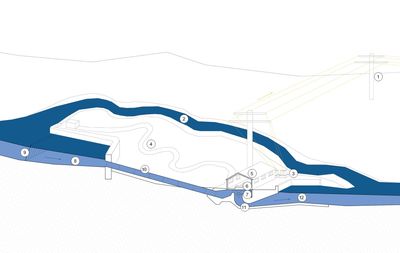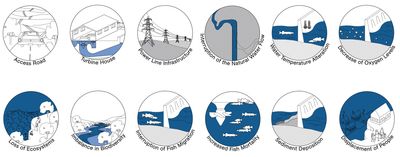AtlasWater and EWZLisa Müller and Cyrill Ender
Switzerland is often called the water castle of Europe, because many of Europe’s large rivers originate from Swiss mountains and glaciers. The water has been used since more than 150 years for electricity production. Until the beginning of the 1970s, the majority of electricity–around 90 %–came from hydroelectric power plants, partly from run-of-river power plants and partly from storage power plants. With the introduction of pumped storage power plants, it became possible to pump water from the valley into the reservoir at night using cheaply purchased electricity. During the day, more electricity can then be produced–and sold at a high price. This is known as the refinement of electricity. Today, 60 % of domestic electricity is still covered by hydropower.
The Water in Our Power Socket
An average of around 225 terawatt-hours of energy was consumed annually in Switzerland over the past five years. Dependent on imports, for around 70 % of this, only 30 % are produced domestically. Within the 30 % of the Swiss domestic electricity production, hydropower energy makes up 58.9 %, followed by 32.8 % nuclear energy and 8.3 % renewable energy. However, hydropower is not simply hydropower. If one looks more closely towards the produced hydro energy, it can be further differentiated into three subcategories. Run-of-river hydropower plants, storage hydropower plants and pumped storage hydropower plants. In a head-to-head race, both run-of-river and storage hydropower play a very important role in Swiss electricity production, seeing that they together create almost 95% of the hydro energy. Pump storage, being the youngest typology of hydropower plants, only makes up 4.2 % of Swiss electricity production in terms of hydro energy.
These hydropower plants are located throughout the entirety of Switzerland, creating a hydropower plant belt through the cantons of Wallis, Uri, Glarus and St.Gallen following the alps. As seen on the second map, the hydropower plants with the biggest amount of produced power are located in alpine areas. This is due to the fact that storage hydropower plants, which are mainly located in mountain valleys, produce more power than run-of-river hydropower plants.

left: Domestic electricity production. Source: BFE, Schweizerische Elektrizitätsstatistik, 2022; right: Domestic electricity produced by hydropower plants. Source: BFE, 2024
- Nuclear energy
- Renewable energy
- Hydropower
- Storage hydropower plants
- Run-of-river hydropower plants
- Pumped storage hydropower plant
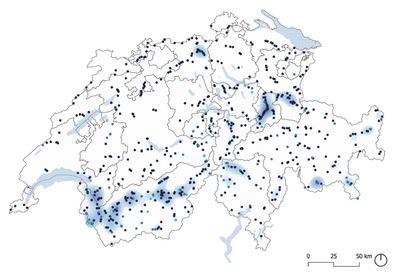
Hydropower plants in Switzerland by type. Source: QGIS, 2024
- Run-of-river hydropower plant
- Mere circulation pump
- Storage hydropower plant
- Pump storage hydropower plant
EWZ—Flooding Boundaries
One of over 600 energy providers in Switzerland is the Elektrizitätswerk Zürich, ewz, which operates way beyond the city boarders.
Contrary to what one would imagine, the ewz isn’t an independent group. Rather, it is a service division of the Department of Industrial Operations of the City of Zurich and therefore reports to the City Council, following three service mandates: Energy solutions, Distribution grid, and Telecom.
The ewz was founded in 1892 by the municipal assembly, at the same time as the run-of-the-river power plant Letten was finished, and was commissioned with the electricity supply, mainly for Zurich’s street lighting. Already at the end of the same year, over 4000 lamps were powered by ewz.
Over time, the city grew, and several municipalities were incorporated. The first incorporation took place in 1893 and 12 independent communities became part of Zurich. With the second incorporation in 1934, Zurich grew by a further eight municipalities.
With this growth, not only the number of inhabitants grew, but also the energy demand, and soon, the produced energy by Zurich’s own hydro power plants wasn’t enough anymore. Contracts were made with the Canton of Graubünden and already in 1909, energy produced by hydro power plants in the Swiss alps ran through a 140 km long overhead power line into the city of Zurich.
In ewz’s history, there are two noteworthy milestones. One, in 1949, the people of Zurich authorized the ewz to build the Marmorera Reservoir for 85 million Swiss franks. Two, in 1954, the people of Zurich authorized ewz a credit of 175 million Swiss franks for the power Plant Bergell, consisting of the hydro power plants Löbbia, Castasegna, Bondo, and Lizun, which, over all, were able to produce energy for about 100000 urban households.
Today, ewz is involved in 28 different power stations in Switzerland. 18 hydro power plants of which 11 are run by themselves, 3 transition sub stations, 2 nuclear power plants, and 5 ernergy, water, and heat networks. 13 of these 28 power plants are located in the canton of Graubünden, where ewz is responsible for 30% of the energy supply, covering the regions of Bergell, Oberhalbstein, Albulatal, Rheinebene Chur, Lenzerheide, and Domleschg.
But with that not enough. Ewz is an international investor in energy solutions. In Spain e.g., ewz is involved in a solar thermal power plant, in France there are two contractual partners in nuclear power as well as 14 wind parks, of which five are owned by ewz. Also in Germany, there are six wind parks, four ewz production plants and two involvements. Furthermore, ewz is involved in four wind parks in Sweden as well as three in Norway.
Again, ewz is a service division of the city of Zurich, a dependent institution under public law. On its own, ewz is unable to act. Therefore, the question, why the City of Zurich represented by ewz is investing in other cities, other cantons, even other countries, seams to be obvious. On their website, it is even marked as a frequently asked question. And ewz’s answer is as followed:
“Europe has an integrated energy system with a closely meshed extra-high voltage grid. In physical terms, it makes no difference where a power plant feeds the electricity it produces into this grid. What is important is that as much electricity is produced across Europe as is drawn at the same time. What is important for a secure and sustainable electricity supply is therefore not the place of production, but the amount of renewable energy produced. This is why we invest in renewable energies where the natural resources for the respective technology are most easily available and the requirements in terms of economic efficiency, environmental compatibility and acceptance of the investment are met. These conditions are met for wind power in Germany, France, Norway and Sweden.”
Rivers Unleashed—The Odyssey of Hydro Power
Up until 1850:
Already before 1850, the potential of water as a power source was recognized. Various industries such as mills, textile production as well as sawmills placed themselves along rivers allowing rural areas to grow, using water wheels to turn energy into mechanical movement such as rotations for millstones or circular saws.
1850 to 1910:
Since the 1850ies, Switzerland experienced rapid industrialization, leading to an increased energy demand. Engineers began to harness the power of water on a larger scale, with the power plant Thorenberg in 1886 as the world wide first power plant to provide alternate current to a third party over 2 km away.
1910 to 1945:
In the 20th century, hydropower became a significant contributor to Switzerland’s energy mix, particularly as electrification spread across the country. Large-scale hydropower projects were undertaken, including the construction of major dams and hydroelectric plants in the Alps. Several smaller communities fell under the resettlement policy, where people were moved in order to build hydropower plants. Oberriet in 1915, Municipalities in the Wägital between 1922 and 1924, or Communities along the Sihl in 1937, to name a few.
1945 to 1970:
With a lack of resources such as coal from Germany and a period of rapid economic growth after the second World War, Hydropower continued to be a cornerstone of Switzerland’s energy infrastructure, with even further expansion, modernizations, as well as newly built hydroelectric facilities, all enhancing the efficiency and reliability thanks to new technologies, improved designs, and automation systems.
1970 up until today:
In recent decades, Switzerland has focused on optimizing its energy portfolio to balance environmental concerns with energy security and economic competitiveness. Still, hydropower remains a critical component of our renewable energy strategy. But especially in the beginning of the seventies with Switzerland’s first nuclear power plants, environmental activists began to question the impacts of hydropower plants along rivers but especially in the alps.
The Way of Fishing Power
Hydropower harnesses the energy of water in various ways. Hydropower plants can be classified in three different ways: by size, head, or source of water. Size refers to the capacity of power generated in watts, while head indicates the height difference between the water inlet and outlet, which determines the pressure on turbines and thus the power output. The third classification is based on the source of water, which distinguishes three types of hydropower plants: run-of-river, storage hydropower, and pumped storage.
Run-of-River Hydro Power Plant
The oldest method of harnessing water’s energy, run-of-river plants use the natural flow of rivers to generate electricity. To operate effectively, such plants require two specific geographical features: a substantial flow rate in the river and a tilt in the riverbed to accelerate water speed. A side category of the run-of-river hydropower is the bypass hydropower plant. The Bypass hydropower plant essentially functions similarly to the traditional run-of-river hydropower plant, with the slight difference that the hydropower plant is located in a side canal next to the natural river flow.

1: Power lines; 2: Powerhouse; 3: Transformer; 4: Fish ladder; 5 Turbine house; 6: Generator; 7: Turbine; 8: Trash rack; 9: Intake; 10: Draft tube; 11: Outflow
Source: Voith, 2024
Storage Hydro Power Plant
Storage hydropower plants store water behind a dam in a reservoir. Water is released as needed, providing flexibility to generate electricity on demand and reducing reliance on inflow variability. These plants are designed for seasonal storage, offering both baseload and peakload power. Advantages include responding to variable load requirements, flood control, water supply, and irrigation. They are increasingly important for storing energy from other renewable sources like wind and solar power.
Pumped Storage Hydro Power Plant
Pumped storage plants store water in a higher reservoir using excess electricity. When demand increases, the stored water is discharged into a lower reservoir through turbines, functioning similarly to storage hydropower plants. Pumped storage is an energy storage system that narrows the gap between peak and off-peak energy demand. Compared to the other typologies, pumped storage possesses the longest lifespan reaching up to a 100 years.

How Water Destroys Life
Even though hydroelectric power systems are highly efficient, converting 70-90% of water energy into electricity, the different types of hydropower plants have varying environmental impacts. Common impacts include the construction of access roads, turbine houses, alterations in water temperature and oxygen levels, and the installation of power line infrastructure, all of which can disrupt natural water flow. Specific impacts depend on the type of hydropower plant, such as fish migration interruption, sediment deposition, loss of ecosystems, displacement of people, and biodiversity imbalances due to water level fluctuations, among others.
